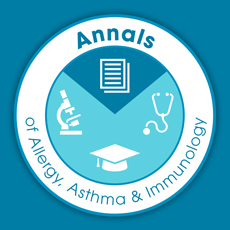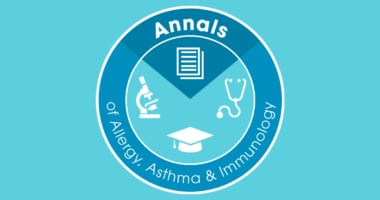 As we move rapidly toward March, things are starting to warm up and bud all over the nation. I hope you have had time to look at the table of contents from the February issue of the Annals of Allergy, Asthma and Immunology. We have a number of features that cover a broad part of our field. I would like to call several to your attention in case you may have missed one.
As we move rapidly toward March, things are starting to warm up and bud all over the nation. I hope you have had time to look at the table of contents from the February issue of the Annals of Allergy, Asthma and Immunology. We have a number of features that cover a broad part of our field. I would like to call several to your attention in case you may have missed one.
First is an article by Toby Lewis, MD, MPH, and colleagues on behalf of the Community Action Against Asthma’s Steering Committee, that assessed the effects of community-acquired respiratory viral infections on asthma control in urban children. They studied 53 children with asthma from Detroit for one year, assessed their frequency of viral respiratory infections and correlated that with asthma symptom score, spirometry, FeNO and nasal aspirate biomarkers. They found that children with asthma with high-symptom respiratory viral infections have reduced FEF25%-75% and more elevations of nasal biomarkers than children with mild or symptomatic infections or virus-negative illnesses. This adds both evidence to the well-appreciated clinical association of colds and asthma activity as well as possible future therapeutic targets to mitigate the comorbidity of coryza in children with otherwise well controlled asthma.
More can’t-miss content from Annals:
Another paper of interest is by Keith Sacco, MD, and colleagues, who report on educating health care professionals about an inpatient beta-lactam test-dose protocol as the basis for an antimicrobial stewardship program with risk stratification guidelines in patients with self-reported history of penicillin allergy. They then compared current standard of care with post-educational care as assessed by relative use of cephalosporins and penicillins in these patients instead of broad-spectrum antibiotics such as vancomycin, quinolones, carbapenems and aztreonam. They found a substantial decrease in the use of broad-spectrum antibiotics with a concomitant increase in cephalosporins and penicillins. These findings add strength to the growing argument for well-defined antibiotic stewardship and further demonstrate the central role that the practicing allergist-immunologist should be playing in developing and implementing inpatient (and outpatient) antibiotic stewardship programs for reportedly penicillin-allergic patients.
As always, we welcome your feedback, comments, inquiries and suggestions. We want to make our journal better for you, our readers.
Gailen Marshall Jr., MD, PhD, FACAAI
Editor-in-chief

